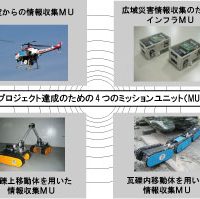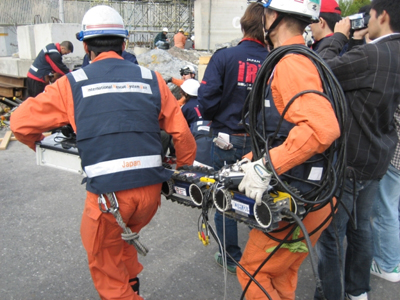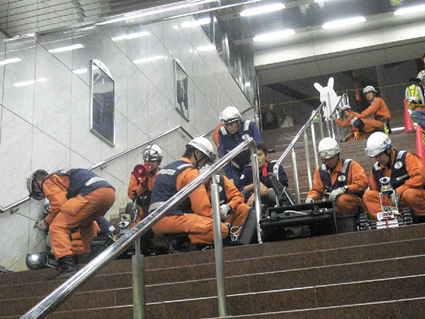Past Research Projects
International Rescue System Institute has been entrusted with research and development projects related to rescue systems, promoting these R&D activities through the industry, government and academia network.
-
2017 Project to achieve an energy saving society where robots and drones play an active role (NEDO)This project concerns the “Implementation of International Standardization in Relation to Robots and Drones”, to understand the trend for international organizations and other foreign groups to promote standardization, and, through international cooperation, to advance investigations and developments, tying together these accomplishments with international standardization.
- 2016 – 2017 World Robot Summit – Studies into contests in the disaster field. (NEDO)
- 2016 Surveys towards accomplishing the World Robot Summit competitive event. (NEDO)
-
2014 – 2018 JST Impulsing Paradigm Change through Disruptive Technologies Program (ImPACT) “Tough Robotics Challenge” (TRC)Impulsing Paradigm Change through Disruptive Technologies Program (ImPACT) is a Japan Science and Technology Agency (JST) program. It was established with the goal of generating innovative science and technology – which if realized could bring about a huge transformation in the nature of industry and society – and the promotion of high risk, high impact, challenging research and development.
The purpose of “Tough Robotics Challenge” is the actualization of remote controlled robots that are tough, tireless and reliable even in situations of extreme outdoor disaster where the conditions are unknown and can change from moment to moment. In the matter of research and development, IRS is responsible for research related to “field benchmark tests and verification tests”.
-
2014 – 2015 NEDO International R&D and Demonstration project in the environmental and medial fields/International R&D and Demonstration Robotics field/Development of benchmark techniques. (Task development)A New Energy and Industrial Technology Development Organzation (NEDO) project, aiming to promote Japanese robotics, and establish a position internationally through the development and verification of robotic systems in cooperation with foreign countries. Systems which have Japanese robotic technology at their core. Furthermore, it aims to contribute to the strengthening of industrial power of Japanese robotic systems, by setting up initiatives and connections those who are working towards a basic adaptability assessment system for the safety of disaster response robotic systems both at home and abroad.
IRS is responsible for the development of assessment system techniques (task development), and regarding DRC (DARPA Robotics Challenge) task development, contributes to assessment systems for future disaster response robots, in collaboration with the USA (DOD, DARPA etc.) .Tasks are also developed for the use of the JVRC (Japan Virtual Robotics Challenge) -
2013 – 2014 Agency of Natural resources and Energy – Decommissioning Power Reactors/Maintaining Basic Safety TechniquesAn Agency of Natural Resources and Energy project to develop the technological foundations for dealing with a remote crisis, such as remote inspections the condition of a structure in spaces such as pipes where workers have difficulty entering and have no radio communications. This project also aims to obtain knowledge and techniques for the future decommissioning of nuclear power facilities and enforcing basic safety at these facilities, both at home and abroad.
-
2013 Investigation into the Standardization of Special Environment Robots (SERs) and the Promotion of International CollaborationA New Energy and Industrial Technology Development Organization (NEDO) project, to analyze the following three items for consolidations of competitiveness of SERs in Japan: 1) Clarification of the political positioning of SERs, 2) Clarification of mid to long term issues that Japan should pursue, 3) Strategic planning of standardization, safety standards and competitiveness.
R&D issues were identified concerning vital infrastructure for research and performance evaluation, including implementation and human resource development. These issues give SERs in Japan an edge over foreign competitors, and were compiled into a standards R&D project. A meeting was held to examine project details, specifications, accomplishments and applications. Research Results -
2013 – 2015 Japan Society for the Promotion of Science – Grants-in-aid for Scientific Research- Basic Research (B)Grant-in-Aid for Scientific Research are competitive funds that are intended to significantly develop all kinds of scientific research (research based on the free ideas of the researcher), from basic to applied research in all fields, ranging from the humanities to the social sciences. The research projects are selected using a peer-review screening process (screening by multiple researchers whose field of specialization is close to that of the applicant), and the grants provide financial support for creative and pioneering research. IRS is currently carrying out research and development into “Semi-autonomous and remote control systems via the internet on a mobile robot, in order to support search and rescue operations.”
-
2012 NEDO Investigation into the standardization, safety regulations and the strengthening of competitive power of SERsA New Energy and Industrial Technology Development Organization (NEDO) project, to analyze the following three items for the strengthening of competitive power of SERs in Japan: 1) Clarification of the political positioning of SERs, 2) Clarifications of mid to long term issues that Japan should pursue, 3) Strategic planning of standardization, safety regulations and competitive power.
IRS is carrying out investigations into the second item: Clarifications of mid to long term issues that Japan should pursue.
Research Results(PDF) -
2011 – 2012 JST Program to support collaborative research and investigations in an international emergency (J-RAPID)J-RAPID is a JST program to support collaborative activities between Japanese and foreign researchers, in ways of dealing with a severe emergency situation. IRS promoted “Recovery Activities Using Underwater Robots in Tsunami-devastated Areas (2011)” with Texas A&M University, and “CRAWLER Robot with Dual-Use Limbed Locomotion and Manipulation for Void Inspection” University of Denver (2011-12).
-
2009 – 2011 JST Project to Promote Strategic International Cooperation in Science and Technology (US-Japan research)
A JST project conducted in collaboration with the US and concerning “Science and technology to realize a safe and secure society”. Specifically, science and technology which can deal with natural disasters, crime, terrorism, disease, and other social vulnerabilities. International Rescue System is cooperating in research in the field of robotics, with the subject “US-Japan Research Collaboration in Disaster Response Robotics”. After the Great East Japan Earthquake in the spring of 2011, the knowledge and collaborative research gained through this project was used in robots deployed to the disaster site.
▶Assessment Report -
2006 – 2011 FDMA: Promotion of Research into Technology for Fire-Fighting and Disaster Prevention
A system implemented by the Fire and Disaster Management Agency (FDMA), to advance research into fire-fighting technology that can ensure a safe and secure society. IRS is currently conducting research and development into “Improvements and Field Tests for the Practical Use of the Active Scope Camera”.
◆Previous Project Reports
“Development of Techniques for Locating Victims Buried in the Rubble of Buildings etc., which have Collapsed in an Earthquake.”
“Development of Hydraulically or Pneumatically Driven Tools for Search and Rescue.” -
2006 – 2011 Project to Develop the Underlying Technology for Strategic, Cutting-edge RoboticsA NEDO project promoting the development of underlying technology for cutting edge robotic systems. Within the “RT Systems Operating Within Disaster Struck Buildings”, (3) Robots for Use in Specialist Environments, International Rescue System Institute carried out the research and development of multi-mobile RT Systems which can rapidly collect information about humans stranded in dangerous locations, such as plant accidents, NBC terrorism, gas leaks and other hypothetical disasters. One of the robots developed, “Quince”, was used for surveying and monitoring the conditions inside Fukushima Daiichi Nuclear Power Plant.
-
2007 – 2009 Project to Develop Next Generation Intelligent Robotic TechnologyA NEDO project promoting development of the intelligent technology necessary for enhancing facilities, and aiming to establish underlying technology needed for independent next-generation robotics. International Rescue System Institute carried out the research and development “Intelligent Motorized Mobility Systems Combining Automation and Operation”, as part of the development of intelligent mobility (in social and lifestyle areas).
-
2006 – 2007 A Ministry of Economy, Trade and Industry (METI) R&D Project for the Regional Revitalisation Consortium.A METI venture for the development of regional technology, with the aim of implementing advanced R&D for practical use. This project was carried out under Industry-Academic-Government’s stable collaborative research structure (Regional Revitalisation Consortium), in places that implement the expertise and seeds of technology (such as universities), to generate new industry and projects, and devise ways to stimulate the local economy. Within this venture, International Rescue System Institute’s Kobe Laboratory carried out the arrangements for the entire project “System for the Prevention of Disasters and Crime by means of RT Applied Mesh Net Sensor. (Kansai Bureau of Economy, Trade and Industry)”
-
2002 – 2006 Osaka City Special Project for the Reduction of Earthquake Disasters, Ministry of Education, Culture, Sports, Science and Technology (MEXT).The “Osaka City Special Project for the Reduction of Earthquake Disasters” was one of the urban regeneration programs started in 2002 by MEXT. A R&D project spanning 5 years, with the aim of developing technology to rapidly reduce the harm caused by earthquakes occurring in metropolitan areas (such as the Great Hanshin Awaji Earthquake, 1995).
 In a subproject called “III. Optimisation of Strategies to Deal with Disaster (Victim Rescue), 4. Development of Next Generation Disaster Prevention Based Technology such as Rescue Robots.”; International Rescue System Institute carried out R&D, such as Robot Intelligent Sensor Ubiquitous Terminal Human Interface, that aims to support the search for missing persons, collection and transmission of data etc. for emergency disaster relief (lifesaving etc.) in earthquakes.
In a subproject called “III. Optimisation of Strategies to Deal with Disaster (Victim Rescue), 4. Development of Next Generation Disaster Prevention Based Technology such as Rescue Robots.”; International Rescue System Institute carried out R&D, such as Robot Intelligent Sensor Ubiquitous Terminal Human Interface, that aims to support the search for missing persons, collection and transmission of data etc. for emergency disaster relief (lifesaving etc.) in earthquakes.
For example, promoting the research and development of technology, such as robots, which can be brought in and mobilized in disaster struck environments which are dangerous for humans to enter, enabling the effective search for bodies and collection of data. By making the search and collection of information in places such as collapsed buildings of underground areas possible, this research has served the purpose of preventing secondary disasters harming people like firefighters.
It also tackled research and development into technologies such as robotic and ubiquitous terminals, and scattering based sensors that collect and integrate data from affected areas to aid rapid decision making at times of disaster. By mapping the disaster’s data and collecting information in real time, this research, besides monitoring the disaster’s situation, uses simulations to enhance the accuracy of predictions for how damage will progress, and supports decision making in the mobilisation of rapid response teams. -
2005 – 2015 Project to Promote Kobe’s RT (Robot Technology) VisionAs part of “Kobe’s RT Vision” promoted by Kobe city, International Rescue System Institute, in conjunction with the advancement of research and development such as rescue robotics, has also carried out the following work.
-
- ・Management of the Kobe RT Business Platform
Planning and management etc. of the “Kobe RT Business Platform”, which aims to generate new RT business.
- ・Management of the Kobe RT Business Platform
-
- ・“Manufacturing as Personnel Training Project” at the Kobe Robot Workshop
Management of Robot exhibition areas, and planning and operation of “Kobe Kids Robot Club” and “Robot Mini Course”, etc.
- ・“Manufacturing as Personnel Training Project” at the Kobe Robot Workshop
-
- ・Management of “Kobe RT Institute for the Joint Development of Products”
Backing of joint developments between small to medium manufacturers within Kobe City, and large-scale businesses that tackle the development of products making use of robotic technology.
- ・Management of “Kobe RT Institute for the Joint Development of Products”
- (1) Entire coordination
- (2) Promotion of joint developments (in the livelihood support and service robot spheres)
- (3) Promotion of joint developments (in the industrial spheres)
-
-
Project to generate innovation – “Society in population decline x Manufacturing technology”Putting excellent manufacturing technology to use, beginning with the robotic technology of medium to small companies in Kobe, and acting as a consultant for the research, prototype development, and production of devises instrumental in solving issues, such as labour shortages in certain spheres due to the problem facing Kobe city of low birth rates and a growing proportion of elderly people.
- 1. Survey and analysis of needs, verification of the problems, considering the feasibility.
- 2. Discussing a development subject/theme/project
- 3. Liaison and coordination with related organisations.
- 4. Supporting the technology of medium to small organisations.
- 5. Promoting prototype development.
- 6. Supporting verification tests etc.
-
Academic teaching unit for the authorisation of service robot safety techniciansThe service robot industry is growing, and is expected to play a role in the lives of future generations. On the other hand, nationally, there are a lack of technicians who can correctly understand and use the international safety standards which are common practice. Therefore, the training of safety technicians is imperative for the progression of the service robot industry.
As of 2007, International Rescue System Institute, in cooperation with the Research Institute for Safety Engineering NPO, has started an academic teaching unit for the authorisation of service robot safety technicians, elementary level, 1. To understand the concept of the international safety standards in relation to service robots, 2. Acquisition of skills related to service robots, 3. Implementing risk assessments. In 2008, the academic teaching unit for the authorization of service robot safety technicians, intermediated level, will begin. An enhanced training program with more continuity is being developed.
▶At the Society of Instrument and Control Engineers, System Integration division’s 9th Lecture, lectures relating to this training program were commended with an award of excellence.
▶Schedule⇒No current plans
- Urban Regeneration Project: Formation of a robotics industry for livelihood support based in the Osaka area.

IRS-U (International Rescue System Unit)
Working Towards an “International Rescue Team” Deploying Robotic Technology
In recent years, the frequency in which natural disasters (such as earthquakes, typhoons, floods and heavy snow) occur has grown exponentially. Simultaneously, man-made disasters like train derailment accidents, nuclear power plant incidents, and terrorism have been on the rise. Although rescue efforts are deployed, there is an ever-constant danger of a secondary disaster to be followed. Consequently, our society is obligated to pursue ways that would put the safety of these rescue teams first.
At International Rescue System (IRS), we aim to encourage research and develop rescue robots for search and rescue missions, like finding victims trapped in debris and gathering information at a disaster sites. In order to implement a rescue robot system, we believe it is necessary to create a unified system which integrates cutting-edge technology and the people from emergency relief teams across Japan.

Unfortunately, many newly developed robotic systems lack the knowledge gained from practical experience. At IRS, we repeatedly conduct demonstrations and drills using robots alongside firefighting officials and local governments. Evaluations of the performance and operability of the robot rescue systems from team members are brought back to researchers, and further development is underway with the aim of practical application at disaster sites. In March 2006, IRS launched the International Rescue System Unit (IRS-U), a volunteer recue team made up of fire, rescue, and paramedic personnel.
We imagine Japan, one of the world`s most earthquake-prone countries and a leader in robotic advancement, to become a place that can take initiative through its developed robot equipped rescue teams, heading to the disaster frontlines and freeing victims from the rubble. Here, IRS-U is working tirelessly to make this thought a reality.
IRS-U’s Endeavors
1) Participation in rescue robot demonstrations and assessments.
2) Participation in the training of rescue robots for real-life emergency situations.
3) Conducting seminars and conferences on rescue robot systems.
The above mentioned are planned and managed by IRS.

